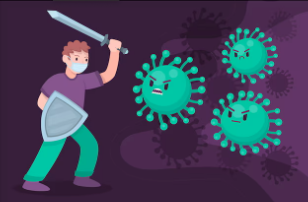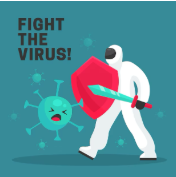By: Geraldus Sigap

HMPV was first identified in 2001, though it has likely been circulating for over 60 years. It belongs to the Pneumoviridae family, closely related to respiratory syncytial virus (RSV). HMPV primarily affects the respiratory tract, causing upper and lower respiratory infections. On the other hand, COVID-19 emerged in late 2019 as a novel coronavirus belonging to the Coronaviridae family. Unlike HMPV, which has a long history of relatively stable behavior, SARS-CoV-2 rapidly spread globally, causing a pandemic with significant social and economic impacts.
Transmission and Contagion
Both HMPV and COVID-19 are transmitted through respiratory droplets, close contact, and contaminated surfaces. However, SARS-CoV-2 has a higher transmission rate, partly due to its ability to spread via small aerosols, which can remain suspended in the air for extended periods. HMPV transmission primarily occurs through larger droplets and direct contact, making close proximity the main mode of spread.
COVID-19 is also notable for its potential to spread from asymptomatic individuals, which has contributed to its rapid global spread. HMPV, while highly contagious, is less likely to spread from individuals without symptoms. Maintaining hygiene practices, such as frequent handwashing, mask-wearing, and physical distancing, is effective in preventing both infections.
Symptoms of HMPV and COVID-19
The symptoms of HMPV and COVID-19 often overlap, making it challenging to distinguish between the two based on clinical presentation alone. Both can cause:
- Fever
- Cough
- Shortness of breath
- Fatigue
- Nasal congestion or runny nose
However, COVID-19 has some unique symptoms that are less commonly associated with HMPV, such as loss of taste or smell, muscle aches, and gastrointestinal symptoms like diarrhea and nausea. HMPV infections are typically milder in healthy individuals, often resembling a common cold, though it can lead to severe respiratory conditions such as pneumonia or bronchiolitis in young children, older adults, and immunocompromised individuals.
COVID-19, by contrast, has a broader spectrum of disease severity, ranging from mild cold-like symptoms to life-threatening complications such as acute respiratory distress syndrome (ARDS), blood clots, and multi-organ failure.
Severity and Risk Groups
HMPV primarily affects young children, with most cases occurring in those under five years of age. It is also a significant cause of respiratory illness in older adults and people with weakened immune systems. While severe cases can require hospitalization, the overall mortality rate for HMPV is low.
COVID-19 poses a more significant threat across all age groups, especially among older adults, individuals with pre-existing health conditions like diabetes and heart disease, and those who are immunocompromised. Unlike HMPV, COVID-19 has caused widespread fatalities and has led to long-term health complications in some patients, known as long COVID.
Diagnosis of HMPV and COVID-19
Accurate diagnosis is crucial for effective management of both HMPV and COVID-19. HMPV is typically diagnosed using reverse-transcriptase polymerase chain reaction (RT-PCR) tests, which detect viral RNA in respiratory specimens. This method is highly sensitive and can distinguish HMPV from other respiratory viruses like RSV or influenza.
COVID-19 diagnosis also relies on RT-PCR testing, but rapid antigen tests are widely used for quicker results. Chest imaging, such as X-rays or CT scans, may be employed in severe cases of both diseases to assess lung involvement. However, these imaging techniques cannot specifically differentiate between HMPV and COVID-19.
Treatment and Management
Currently, there are no specific antiviral treatments for HMPV. Management focuses on relieving symptoms through supportive care, such as rest, hydration, and over-the-counter medications to reduce fever and congestion. In severe cases, oxygen therapy or hospitalization may be required.
For COVID-19, treatment options have evolved significantly since the start of the pandemic. Antiviral medications like remdesivir, monoclonal antibody therapies, and corticosteroids such as dexamethasone are used for moderate to severe cases. Supportive care, including oxygen therapy and mechanical ventilation, is crucial for patients with severe respiratory distress. Vaccines have also played a pivotal role in reducing the severity of COVID-19 and preventing hospitalizations.
Prevention Strategies
Preventing HMPV and COVID-19 requires similar hygiene measures. These include:
- Regular handwashing with soap and water
- Using hand sanitizers with at least 60 percent alcohol when soap is unavailable
- Wearing masks in crowded or indoor settings
- Avoiding close contact with sick individuals
- Cleaning and disinfecting frequently touched surfaces
Vaccination is a critical preventive measure for COVID-19, with multiple vaccines available globally. Although there is currently no vaccine for HMPV, research is ongoing, and experimental vaccines are in development. Until a vaccine becomes available, adhering to general hygiene practices remains the best way to protect against HMPV.

| Category | COVID-19 | HMPV |
| Virus Family | Coronaviridae | Pneumoviridae |
| First Identified | 2019 | 2001 |
| Primary Symptoms | Fever, cough, shortness of breath, fatigue | Fever, cough, nasal congestion, wheezing |
| Unique Symptoms | Loss of taste or smell, muscle aches, gastrointestinal symptoms | None unique; resembles cold or flu symptoms |
| Transmission | Respiratory droplets, aerosols, contaminated surfaces | Respiratory droplets, direct contact with contaminated surfaces |
| At-Risk Groups | Older adults, individuals with chronic illnesses, immunocompromised | Young children, older adults, immunocompromised individuals |
| Diagnosis | RT-PCR, rapid antigen tests | RT-PCR |
| Treatment | Antivirals (e.g., remdesivir), monoclonal antibodies, supportive care | Supportive care (rest, hydration, symptom management) |
| Prevention | Handwashing, masks, physical distancing, disinfection | Handwashing, masks, physical distancing, disinfection |
| Vaccination | Available and widely used | Not available yet |
Table 1. Summarize of the difference between COVID-19 and HMPV
If you or a loved one are experiencing respiratory symptoms, consulting a pulmonology specialist is essential for accurate diagnosis and effective management. RS Abdi Waluyo provides comprehensive care for a wide range of respiratory conditions, including HMPV and COVID-19. Equipped with many diagnostic tools and advanced treatment options, our specialists tailor their approach to each patient’s unique needs.
Resources
- García-García ML, Pérez-Arenas E, Pérez-Hernandez P, et al. Human Metapneumovirus Infections during COVID-19 Pandemic, Spain. Emerg Infect Dis 2023;29(4):850–852.
- Jongbloed M, Leijte WT, Linssen CFM, Hoogen BG van den, Gorp ECM van, Kruif MD de. Clinical impact of human metapneumovirus infections before and during the COVID-19 pandemic. Infect Dis 2021;53(7):488–497.
- Uddin S, Thomas M. Human Metapneumovirus [Homepage on the Internet]. In: StatPearls. Treasure Island (FL): StatPearls Publishing, 2025 [cited 2025 Jan 8]; Available from: http://www.ncbi.nlm.nih.gov/books/NBK560910/
